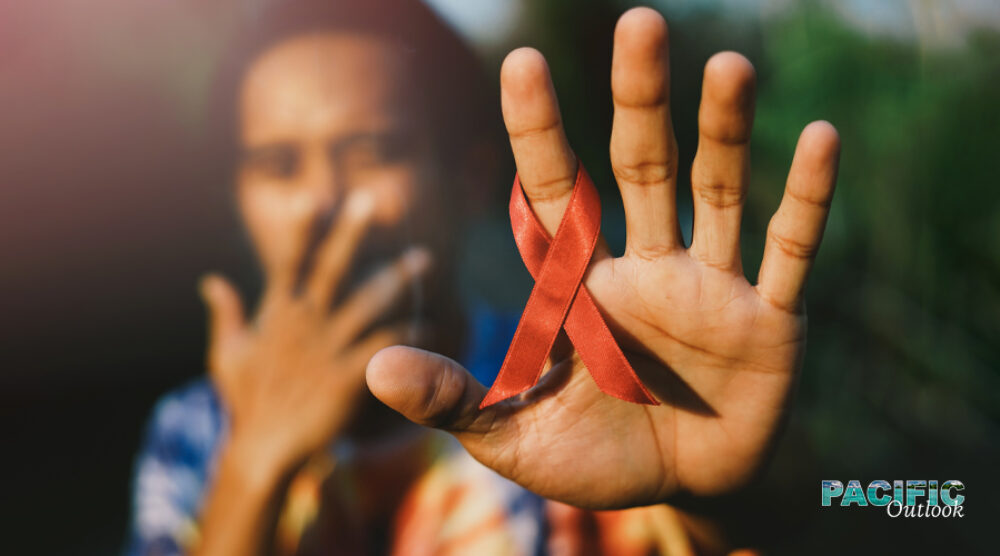Over the last decade, Pacific island countries have had to deal with a multitude of problems, with the increase in non-communicable diseases, vector-borne diseases (dengue, malaria, zika, leptospirosis), climate change, natural disaster response and COVID-19. While national governments have done their best within their available resources and managing donor driven programs, they have had to put some areas on the back burner such as HIV/AIDS, which when left to simmer for too long, can start to overflow.
The impact of this is that the Pacific now has a generation of young people with low HIV knowledge, poor HIV testing uptake, low condom use, high levels of stigma and discrimination, dense sexual networks, high STI rates, poor comprehensive sexuality education (CSE) coupled with the use of social media and dating apps such as Tinder and Grinder, plus the emerging threat of synthetic drug use and needle-sharing for drug consumption. The Pacific has not caught up with game-changing interventions such as pre-exposure prophylaxis (PrEP), community-led programming, and needle-exchange programs, due to resource constraints and lack of donor priority.
What is the data telling us?
HIV transmission is on the rise, treatment targets are off track and AIDS-related deaths are continuing. A country of concern is Fiji. In the latest UNAIDS Global AIDS Update Fiji is noted as one of 38 countries with estimated increasing HIV new infections. Since 2010 there has been an increase of 129 per cent. Further to this, there has been a 173 per cent increase in AIDS-related deaths between 2010-2021. The report estimates that for Fiji, there are 1400 people living with HIV (PLHIV), with 57 per cent who know their status and 45 per cent of the estimated numbers receiving antiretroviral treatment (ART).
The Fiji Multiple Indicator Cluster Survey (MICS) revealed concerning gaps in sexual health knowledge and practice; only 30 per cent of women and 26 per cent of men aged 15-24 years, are knowledgeable about HIV prevention.
The survey revealed very low condom use among people with multiple partners stating that 24 per cent of men and 9 per cent of women between the ages of 15-49 years old had reported using a condom at their last sexual encounter.
The MICS has further revealed poor health-seeking behaviours and knowledge of HIV status in Fiji. The proportion of people aged 15-49 undergoing HIV testing in the last 12 months and knowing their test results are extremely low at 7 per cent and 4 per cent, respectively.
New HIV related risks:
Anecdotal evidence suggests that young people in Fiji and Tonga are consuming synthetic drugs such as methamphetamine. These are administered intravenously and normally needles are shared. Such “party drugs” are used in chem sex practices, which is when a group of people under the influence of these drugs engage in sexual activities, typically without the use of condoms. Dating apps and social media are now used widely in the Pacific for dating. For sexual health, this has made sharing information and distributing products such as condoms and lubricants a challenge. Before there were actual physical hotspots such as nightclubs, sporting events, and festivals as places where people met, Now this has shifted into a virtual space. Privacy and anonymity, within these spaces, makes it easier for more sexual meetings with an increased number of partners.
A very conservative environment and increased use of mobile technology can be a dangerous combination for young curious people who are accessing the internet to learn about sexual health. The lack of CSE is fueling the drivers of STIs & HIV here in the Pacific. The current approach to sexual education in focuses largely on family planning and is targeted at women & girls. It misses out on sexuality, sexual health and vulnerable groups who are at higher risk of HIV and STIs such as men who have sex with men, sex workers, and transwomen.
A Pacific health security threat:
Fiji is the ‘hub of the Pacific’, it is a transit point for the vast migration between the Pacific, Australia and New Zealand. This is a red flag for disrupting health security among these countries. Past trends have suggested that risky behaviours prominent in Fiji tend to extend to other Pacific Island countries. If unaddressed these trends could pose serious threats to the HIV situation in the Pacific, given the global experience of synthetic drug use and the re-emergence of HIV waves. The existence of HIV drivers coupled with poor HIV data and behavioural studies will lead to a health security crisis in the Pacific. The international community needs to support national action to avert this crisis.
There are four areas of focus for national and/or regional action. First is the need to strengthen data for better programming purposes. Countries need to ‘know their epidemic’: who are the key populations and age groups, what are the behavioural trends, what are the health-seeking trends? Having better data enables countries to tailor programs for greater impact. Secondly, there is the need to upscale community-led programs through a combination prevention approach. This includes providing prevention commodities such as condoms, PrEP, testing and treatment. A combination package encourages regular testing and stronger retention to treatment as a form of prevention. Third is the need to improve communication for empowered safer choices and create demand for better health-seeking behaviour for prevention, testing and treatment. Finally, there is the need to introduce prevention programs for people who use drugs, through harm reduction strategies such as needle-exchange initiatives to mitigate the risk of new infections from the sharing of needles and PrEP. These actions need stronger support from the international community for resource mobilisation, technical assistance and south-south cooperation.
Renata Ram is the Country Director for UNAIDS Pacific Country office based in Suva, Fiji covering 14 Pacific island countries.








